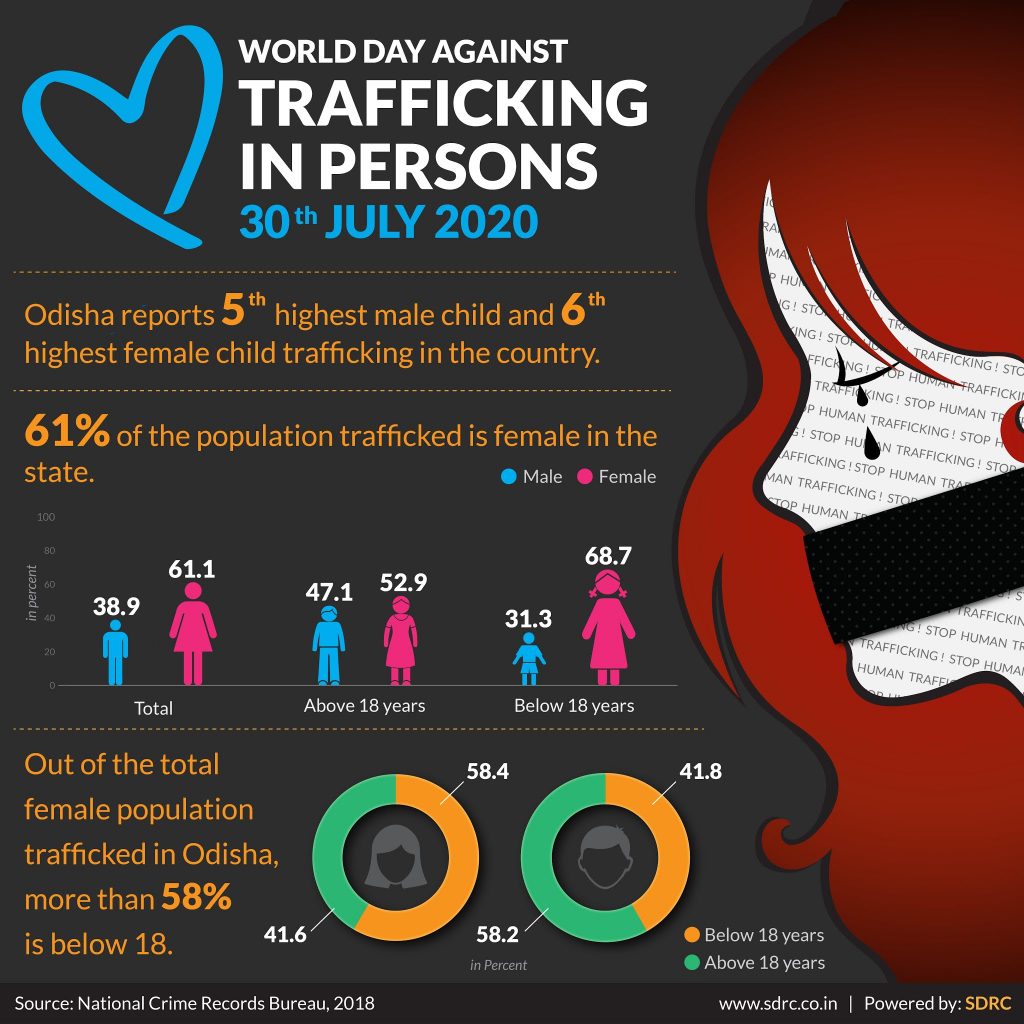Human trafficking – particularly of women and children – is a serious problem and Odisha is witnessing a rise in the organized crime. The numbers of missing persons have increased in the state, while the successful tracing, rescue, and rehabilitation remained abysmally low.
As per the NCRB 2018 Report, the state reported 10,193 cases of ‘disappearance of women’ as compared to 4,187 cases in 2017 – an increase of nearly 144%. The cases of missing children also increased marginally – 2,326 missing cases in 2018, compared to 2,244 cases in 2017.
The data also indicated that Odisha Police lagged in tracing the missing persons compared to other states. The police force could trace only 25% of the women and 29.2% of men who went missing in 2018.
In terms of total number of trafficking cases, Odisha ranks 11th among all Indian states and union territories.
Government initiatives to check human trafficking
As the state witnessed rising human trafficking cases, the government initiated some measures over the years to keep the number of cases in check. Some of them are:
Integrated Anti Human Trafficking Unit: In 2009, the state government framed a comprehensive policy to prevent human trafficking. In 2013, the state government’s home department had sanctioned the establishment of 25 Integrated Anti Human Trafficking Units in various parts of the state. Functions of Anti Human Trafficking Unit:
- Timely collection, transmission, and use of intelligence about human trafficking
- Trace and rescue maximum number of trafficked persons
- Proper investigation, prosecution, and conviction of offenders
- Maintain monthly database to share with Ministry of Women and Child Department, Ministry of Home Affairs, and National Crime Records Bureau
- Carry out any supporting activity to combat and prevent human trafficking
Corrective measures and remedies: In 2019, a study was conducted by the state Crime Branch, Odisha Police and Sambalpur University to find out the remedies of human trafficking. The report suggested corrective measures at three levels:
- Families: Households must be sensitized against human trafficking
- Communities: Communities need to come together to shield members from exploitation
- Government: Government agencies need to develop mechanisms to prevent trafficking in the first place, and to rescue and rehabilitate the victims.
Provisions under Odisha State Policy for Girls and Women 2014: The state government policy, which provides an actionable and comprehensive framework for overall development of girls and women, has provisions for trafficked girls and women. This has directives to:
- Provide migrant support services for trafficked girls and women at source and destination so that they can secure their rights and entitlements
- Devise proper mechanisms for universal registration of marriage to prevent young girls and women from falling trap to false marriage promises
- Create proper forums at community level to track, monitor and report instances of violence and trafficking of girls and women
What the state can do more to prevent trafficking of persons?
Strict laws: On July 2, Odisha High Court said despite the heinousness of girls and women trafficking for commercial sexual exploitation it attracts a maximum jail term of three years, whereas drug trafficking attracts a minimum term of 10 years. The laws related to human trafficking needs to be stricter and exemplary.
Creating Awareness: The state government must impart human trafficking awareness training on individual level as well as in community and organizational levels, which would include teachers, community leaders, law enforcement bodies, government officials, first responders, among others.
Community Interactions: Hosting community interactions in schools, colleges, town halls, and public places regarding safety of community members, especially women and children, is a good way to sensitize the issue.
Identifying traffickers’ tactics: The Police Department and intelligence agencies need to recognize the tactics traffickers use to lure and entrap victims and be prepared to catch them upon identifying their activities.
Allocating more funds for the safety of vulnerable people: If the state government allocates more funds for the safety of vulnerable groups, it will be difficult for the traffickers to prey on them. By providing education, internships, skills training, jobs, and other opportunities to vulnerable people, the government can ensure their wellbeing.





More girls and that too more under 18 girls are trafficked in Odisha. It will be useful to understand the dynamics for stricter implementation of the laws for protection of girls.
Apart from stricter implementation of laws, it’s necessary to have more stringent laws in place to deter the rising cases. punishments need to be exemplary. It’s ironic how human trafficking, obviously a more heinous crime than drug trafficking, attracts a maximum jail term of three years, while the latter has a minimum term of 10 years.
IJM has already done a baseline study. And my experience in breaking cycle of crime through network analysis and criminal profiling says that modus operandi changes every now and then. Comfortable with shifting business and the criminals who are not just traffickers but pimps, handlers, agents, customers are smart enough to think ahead and change their business route, agenda and trend. This is another side of human trafficking study…